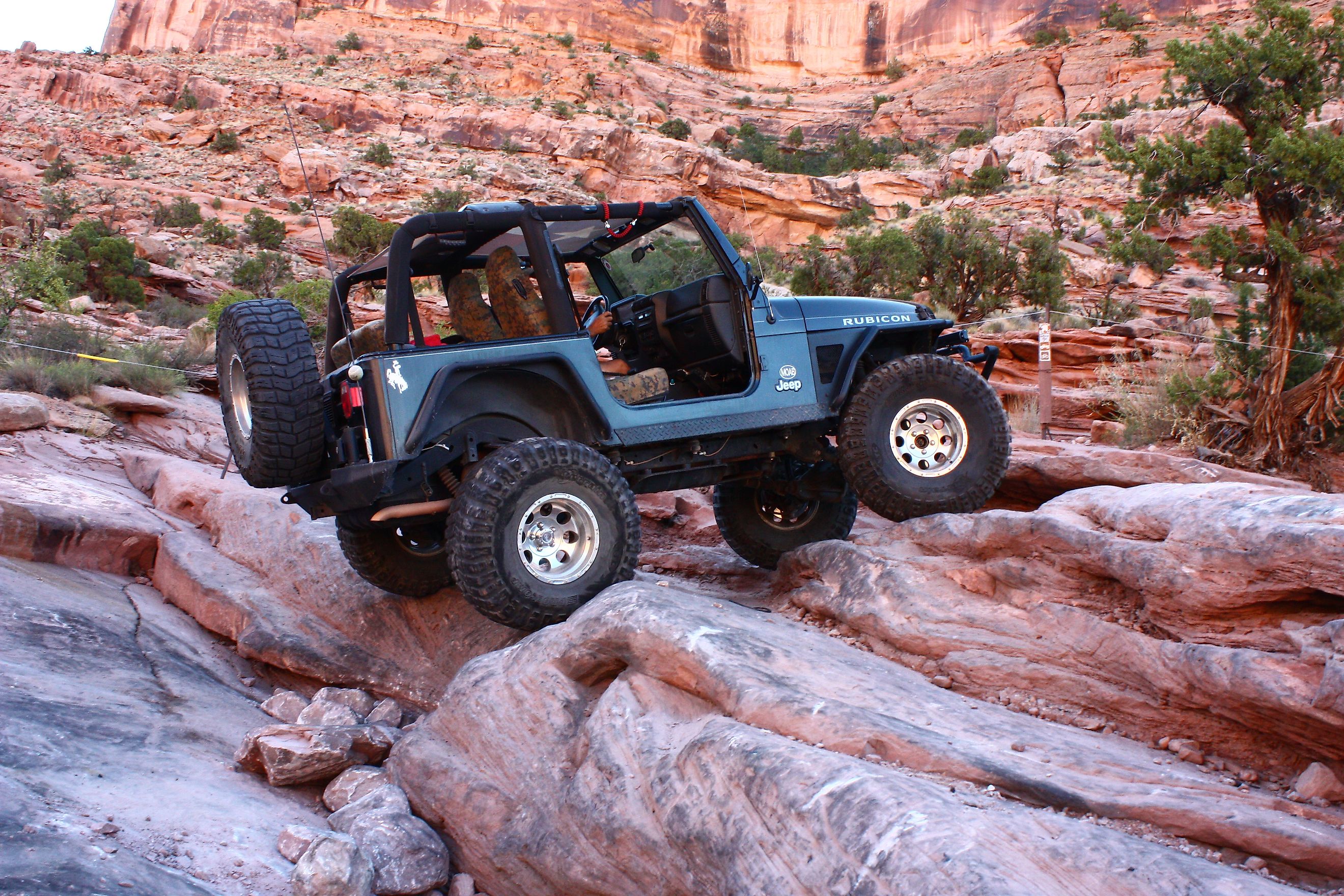
The Adventure Capital of the Southwest
When travelers set their sights on Moab, Utah, they often picture its stunning red rock landscapes, dramatic arches, and incredible outdoor recreation opportunities. It's best known as the gateway to Arches National Park and Canyonlands National Park, showcasing breathtaking natural arches, canyons, mesas, and desert scenery. But Moab offers so much more than red rocks; it’s a living testament to thousands of years of human history and culture from the Ancestral Puebloans (also known as the Anasazi) who left behind cave dwellings and rock art to the arrival of the Mormons who laid the foundation for modern-day Moab.
Today, the combination of the town’s rich cultural history and reputation as a hub for outdoor enthusiasts, adrenaline seekers, and stargazers with some of the darkest skies in the country make Moab a vibrant town worth exploring.
Moab’s Rich Cultural History
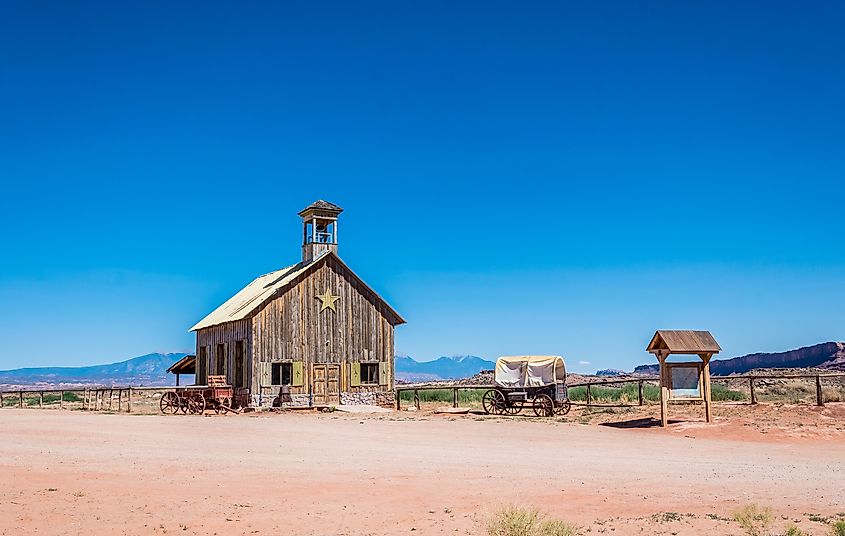
Moab, Utah: old ranch in the arid prairie. Utah State Attractions, United States. Editorial credit: Konoplytska / Shutterstock.com
Moab was initially inhabited by the Indigenous peoples of the Fremont and Ancestral Puebloan cultures from 300 CE to 1300 CE. They lived in the Moab region, an area known as the popular tourist attraction Four Corners, which is located in the southwestern United States and serves as a meeting point for four different states: the northeastern part of Arizona, the southwestern edge of Colorado, the southeastern part of Utah, and the northwestern corner of New Mexico.
The Fremont and Ancestral Puebloan people were hunter-gatherers who developed agricultural practices like growing the three sisters (corn, squash, and beans) and used methods like building their towns around natural water sources and creating irrigation ditches to maximize food production. Signs of their thriving culture are depicted in pictographs (painted images) and petroglyphs (rock carvings) in parks in Utah’s Mighty Five, including Capital Reef National Park, Canyonlands National Park, Zion National Park, and showing human-life figures, animals, resource locations, and travel routes.
The Ancestral Puebloans abandoned the once-thriving farmland around 1300 CE, possibly due to the region's 50-year drought. Following their departure, the nomadic Ute (which means “Yutah”) people began living in the area around the 14th or 15th century. The Utes used the same hunting, fishing, and gathering practices as the previous peoples but added traditions, craftsmanship, and spiritual practices.
Elk Mountain Mission
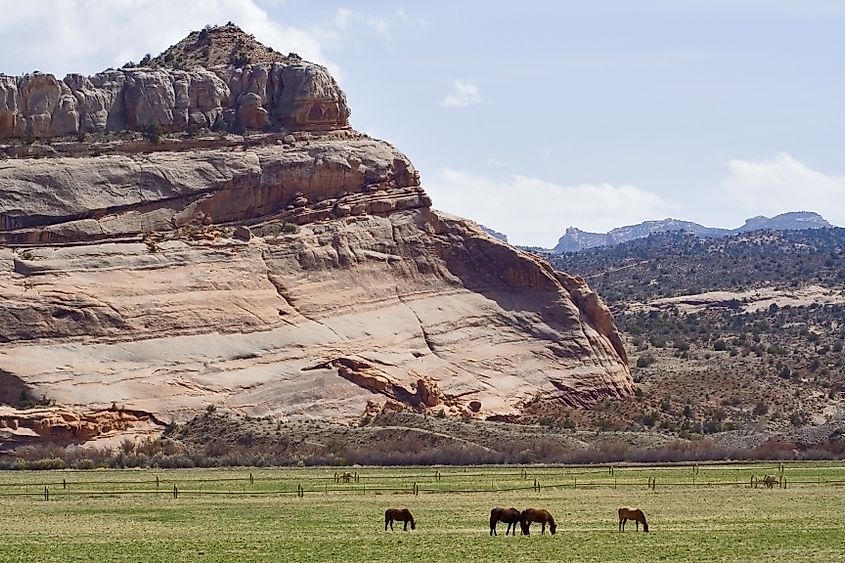
Moab area mountains and spires with horses in Utah USA.
In mid-1855, Mormon settlers from the Church of Jesus Christ of Latter-Day Saints tried to establish a Mormon mission known as the Elk Mountain Mission in the Moab area to convert the Ute to Mormonism. That aspiration was quickly abandoned when conflicts between the settlers and the Ute tribe broke out. By the 1870s, Americans and Europeans arrived in Moab to establish farms, ranches, and stone fruit orchards, and the town went through several name changes, including Spanish Valley, Grand Valley, and Poverty Flats, before being named Moab, referring to the biblical “land before the Jordan.”
The Mormons ultimately returned to the area and established a permanent presence in the Moab Valley. Still, the Elk Mountain Mission is an example of cultural clashes that took place throughout North America in the 19th century. It was part of a more significant trend of cultural assimilation and territorial displacement that Indigenous people faced worldwide. The Moab Museum is a great place to learn more about Moab's cultural and natural history.
Landmarks in the Adventure Capital of the Southwest
Moab offers an unforgettable mix of outdoor activities, adrenaline-pumping thrills, and star gazing. Explore the iconic Arches National Park with its breathtaking rock formations, hike rugged trails, or gaze at the Milky Way in Canyonlands National Park under some of the darkest skies in the U.S. Whether outdoor enthusiasts are into rock climbing, rafting the Colorado River, or simply soaking in the beauty, Moab has the perfect adventure in over dozen natural and geological landmarks, spread across its national parks, state parks, and surrounding landscape.
Hiking in Arches National Park
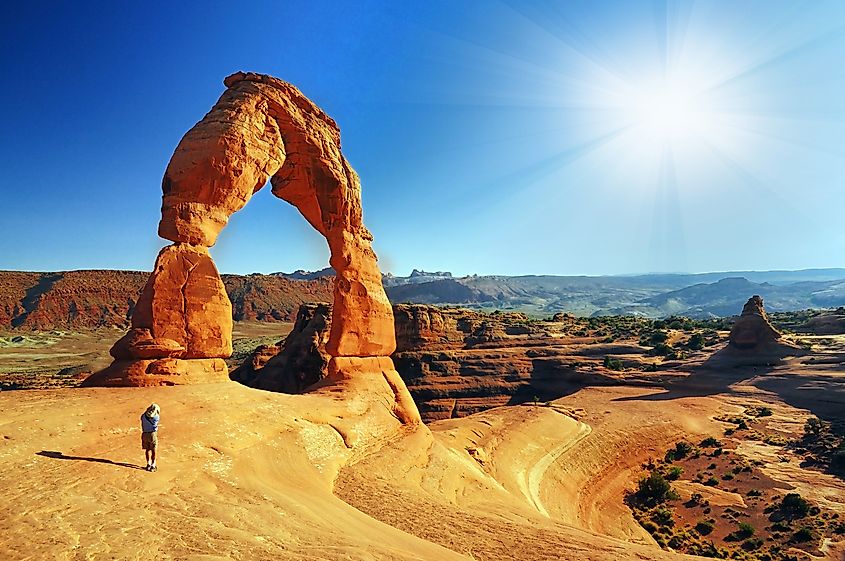
Beautiful Arches National Park.
Just outside Moab, the 73,234-acre Arches National Park is one of the top parks in the United States. The park has more than 2,000 stone arches of varying sizes and prominence, but the crowning jewel is the Delicate Arch, one of the most recognized geological features in the world and a symbol of the state of Utah. It is a much sought-after adventure for hikers: a moderate two to three hour, 30-mile round trip hike up 480 feet. On the way down, take a worthwhile side trip by detouring one-quarter of a mile to see a wall of Ute petroglyphs at Wolfe Ranch.
Rafting Down the Colorado River
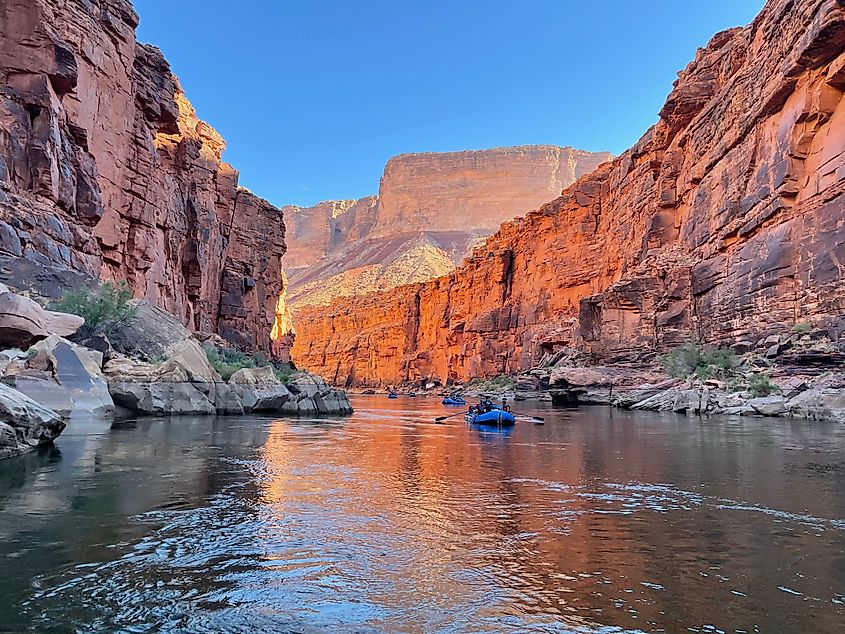
Rafting down the Colorado river.
Thrill seekers won’t want to miss the opportunity for an intense rafting adventure in Cataract Canyon, south of Moab, at the junction of the Green and Colorado Rivers. With 14 miles of rapids ranging from difficulty up to Class V, this whitewater rafting trip is not for landlubbers. Rafting enthusiasts of all skill levels would be smart to book a two-day trip with a qualified guide at any of Moab’s numerous adventure outfitters. Along the way, river rafters will be awestruck by the rock art on cliff faces and boulders—pictographs created by the Ancestral Puebloans and the Fremont people thousands of years ago.
Rock Climbing in Canyonlands National Park
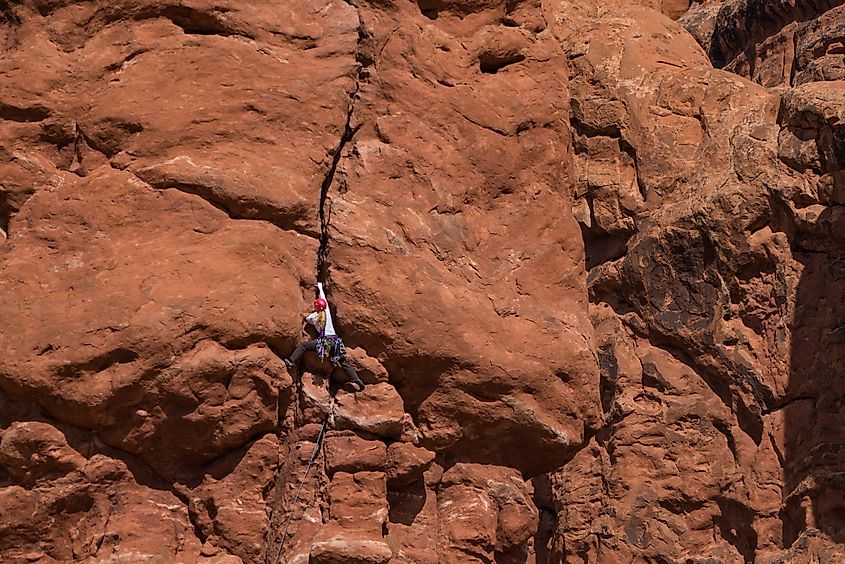
Woman rock climber cliffs in Arches national Park, Utah.
Island in the Sky is a popular area within Canyonlands National Park, renowned for its panoramic view and stunning desert landscapes. Island in the Sky gets its name from its position on top of a mesa over 1,000 feet above the surrounding landscape. The area is a top climbing destination for experienced climbers, especially those with experience in desert tower climbing and crack climbing.
Star Gazing at Dead Horse Point State Park
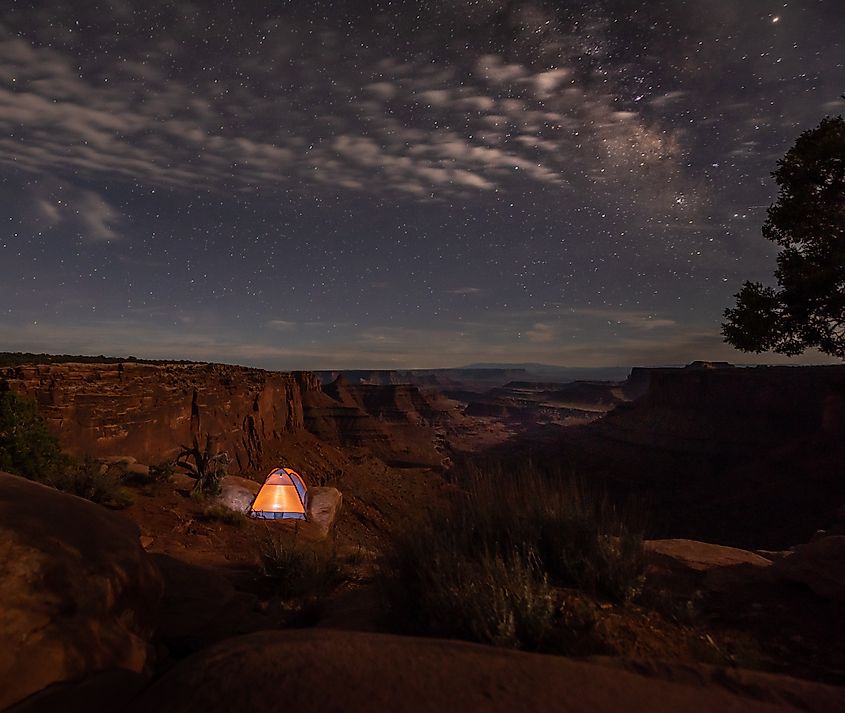
Camping under the stars Small tent on the edge of the canyon Milky Way East Fork Shafer Canyon near Dead Horse Point State Park Canyonlands Utah USA.
Utah has the most certified International Dark Sky Parks in the world, and the Moab area is home to three of them: Arches National Park, Canyonlands National Park, and Dead Horse Point State Park. In 2016, Dead Horse Point State Park became the first Utah state park recognized as an International Dark Sky Park. Located on a high plateau near Moab, it is the premier spot to stargaze away from view-obstructing mountains or cities. With park rangers using telescopes and stories to narrate the dark sky story, would-be astronomers can see the Milky Way, the Perseids Meteor Shower, and the Summer Triangle at various times of the year.
Summary
Moab, Utah, is known as the "Adventure Capital of the Southwest.” While it’s famous for Arches and Canyonlands National Parks, Moab is rich in cultural history, from the ancient Ancestral Puebloans to the arrival of Mormon settlers in the 1800s. With adventures like hiking, rock climbing, rafting, and stargazing, Moab is an attractive destination for outdoor enthusiasts and adrenaline seekers worldwide looking for adventure at iconic landmarks like Delicate Arch, Cataract Canyon, and Island in the Sky. With a rich history, diverse outdoor offerings, and stunning landscapes, Moab remains a vibrant destination for adventure, culture, and so much more than stunning red rock formations.











